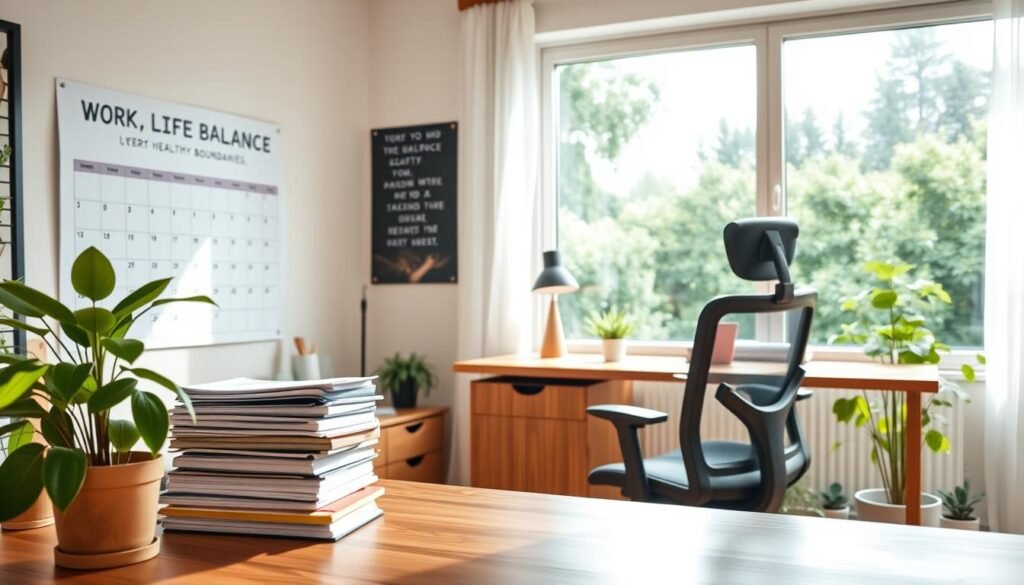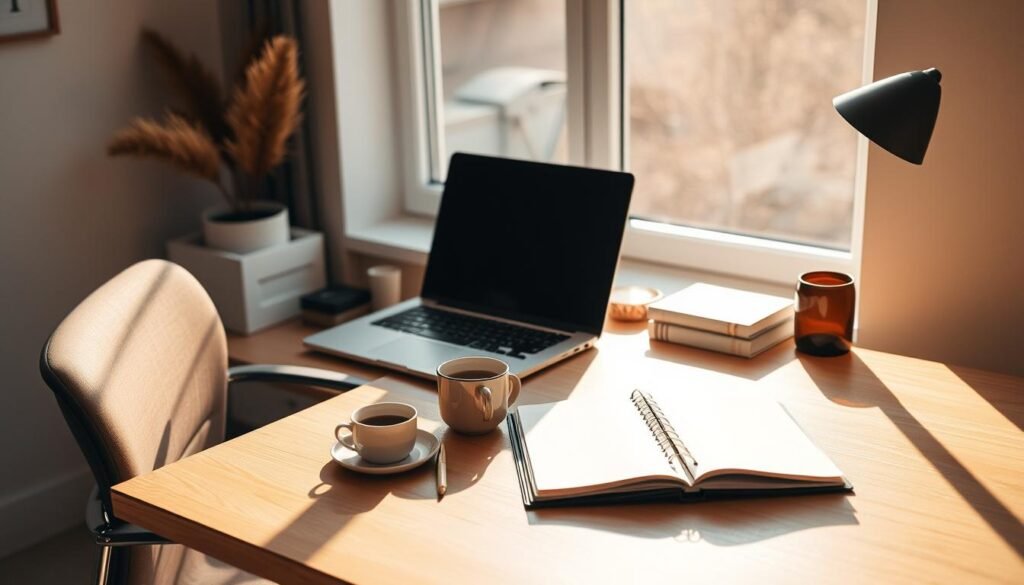Welcome to your go-to guide for blending career success with personal fulfillment in our hyperconnected world. Gone are the days when clocking out meant truly disconnecting. Today’s always-on culture demands fresh approaches to protect your energy and priorities.
Modern professionals face unique challenges. Smartphones keep us tethered to emails, while flexible schedules blur lines between office hours and downtime. Recent studies reveal something surprising: 66% of employees report high job satisfaction even when work and personal time overlap. This proves balance isn’t about rigid separation, but smart adaptation.
Think of balance as a rhythm, not a perfect split. Some weeks demand extra focus on career goals. Others might need more attention on family or self-care. The key lies in regular self-checkups and tweaking your approach when things feel off-kilter.
Key Takeaways
- Today’s work culture requires flexible strategies beyond traditional time management
- High job satisfaction coexists with blended work-personal time arrangements
- Sustainable rhythms beat daily perfection in managing responsibilities
- Self-awareness drives better alignment between professional and personal needs
- Actionable adjustments create lasting improvements in daily routines
This guide walks you through practical methods to design a system that bends without breaking. You’ll discover how to set clear priorities, communicate needs effectively, and recharge authentically – all while excelling in your career.
The Evolution of Work-Life Balance and Its Challenges
The concept of balancing professional and personal responsibilities has shifted dramatically in recent years. Traditional offices once offered built-in structure – desks left behind at 5 PM, commutes acting as mental buffers, and watercooler chats marking natural pauses. Today’s landscape looks vastly different.
Impact of Changing Work Environments
Remote and hybrid setups erased physical boundaries overnight. While 85% of fully remote employees report better flexibility, Gallup data reveals only 33% feel truly balanced. Why the gap? Without office routines, people often overcompensate to prove productivity. The average remote worker logs 2.5 extra hours daily compared to in-office peers.
AI tools amplify this pressure. Constant notifications and automated task tracking keep workers mentally tethered to job demands. Nearly 60% of hybrid staff admit checking emails during family meals or late nights – habits that quietly erode personal time.
Modern Trends in Remote and Hybrid Work
Three key patterns define today’s struggles:
- Blurred schedules: 68% of remote teams overlap work hours with household tasks
- Availability creep: 42% feel pressured to respond instantly to messages
- Vanishing transitions: No commutes mean 53% struggle to mentally “clock out”
These challenges aren’t personal failures – they’re systemic shifts requiring new strategies. As one HR director notes: “Flexibility without intention becomes chaos.” The next section reveals practical fixes for these modern hurdles.
Practical Tips for [establishing healthy boundaries for work-life balance]
Redefining productivity starts with protecting your peak hours. Top performers don’t just work harder – they align tasks with their natural focus cycles. “Schedule personal commitments like board meetings,” advises productivity coach Lisa Marks. “Your hobbies and relationships deserve calendar real estate too.”

Try grouping similar tasks in 90-minute blocks. Research shows this reduces mental fatigue by 40% compared to constant switching. Pair this with transition rituals – closing your laptop lid or changing clothes – to signal the day’s end. One tech CEO swears by her “desk shutdown routine”: organizing notes and spraying lavender mist to mark quitting time.
Building Momentum Through Purposeful Choices
What fuels better focus? Having non-work passions. Marathon trainees report 28% fewer after-hours email checks. Why? Training goals create natural stopping points. As Marks notes: “Excitement about tonight’s guitar practice makes closing Slack easier at 5 PM.”
If you constantly crave escape from work, dig deeper. Does your role use your strengths? Could tweaking projects create more engagement? Sometimes small adjustments – like leading a new initiative – reignite motivation better than drastic changes.
Planning Your Day for Optimal Productivity and Wellbeing
Have you ever felt like your workday bleeds into evenings despite your best efforts? The secret lies in intentional design, not wishful thinking. Let’s explore how to craft days that fuel both career growth and personal renewal.

Scheduling and Time-Blocking Techniques
Time-blocking works like a budget for your energy. Group emails, calls, and creative tasks into themed chunks. Neuroscience shows this reduces mental gear-shifting by 37%. Try the Pomodoro Technique: 25-minute sprints with 5-minute pauses. One marketing director swears by “theme days” – Mondays for planning, Tuesdays for client work.
Align tough tasks with your natural rhythm. Early riser? Slot strategic work before lunch. Night owl? Save brainstorming for afternoon hours. “Your calendar should reflect your biology, not corporate norms,” advises productivity expert James Clear.
Incorporating Breaks and Self-Care
Dr. Farvah Fatima’s research reveals a game-changer: hourly 7-minute breaks boost focus by 28%. Protect lunch breaks like VIP appointments – step outside or chat with family. Use screen-time tracking apps to enforce digital detoxes after 6 PM.
End work rituals matter. Try closing tabs while saying “That’s a wrap!” aloud. One teacher uses her smartwatch to trigger “quitting time” vibrations. These cues help brains transition to personal time seamlessly.
Leveraging Technology to Enhance Work-Life Boundaries
Smartphones and apps often blur lines between office hours and downtime, but they can also become powerful allies in reclaiming personal time. With 40% of Americans admitting they never fully disconnect, intentional tech use proves essential for protecting mental space.
Smart Tools for Focused Days
Apps like Freedom and Focus@Will help maintain concentration during work hours by blocking distracting websites. Set these tools to activate automatically during your peak productivity times. One study found workers using site blockers completed tasks 23% faster.
| App | Blocks | Best Feature |
|---|---|---|
| Freedom | Websites & apps | Cross-device sync |
| Focus@Will | Distractions | Science-backed music |
| Cold Turkey | Social media | Unbreakable sessions |
After 6 PM? Flip the script. Use apps like Offtime to silence work notifications while allowing calls from family. Try designating one phone for emails and another for personal use – 68% of remote workers report better focus with this method.
Create tech-free zones by setting “do not disturb” hours on devices. Dining tables and bedrooms become sanctuaries when phones stay in another room. For urgent projects, schedule emails to send during regular working hours using Boomerang or Outlook delay features.
Mindfulness and Self-Care Practices for a Balanced Life
Your breath holds a secret weapon against workplace stress. Mindfulness acts like a personal radar system, alerting you when professional demands start overshadowing what truly matters. Studies show just 10 minutes daily of intentional practice strengthens decision-making skills by 14%.
Power Through Your Nose
Try this: Inhale for four counts through your nose, hold for seven, exhale for eight. This Navy SEAL-approved technique resets nervous systems in 90 seconds. Pair it with “commute meditation” – close your eyes for five minutes post-work while imagining physical distance from job pressures.
Spotting Trouble Before It Strikes
Persistent neck tension or forgotten lunches often signal approaching burnout. Track these patterns using smartphone reminders: “Did I blink normally today?” or “When did I last laugh?” Early detection prevents 68% of severe stress cases according to Johns Hopkins research.
Evenings become richer when you practice sensory transitions. Light a specific candle scent after logging off, or play a particular song marking personal time. These cues help brains shift gears, protecting both mental health and creativity reserves for tomorrow’s challenges.

![[establishing healthy boundaries for work-life balance]](https://upgrademyfocus.com/wp-content/uploads/2025/07/establishing-healthy-boundaries-for-work-life-balance.jpeg)